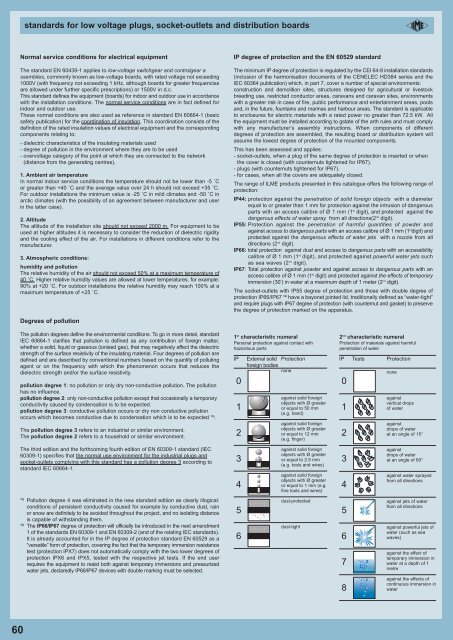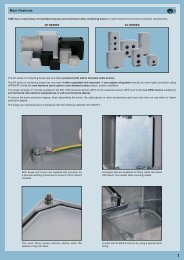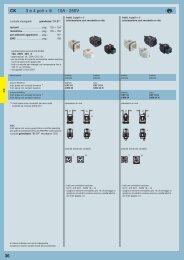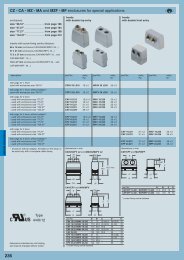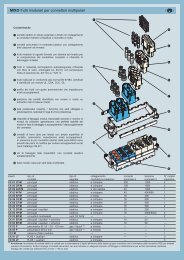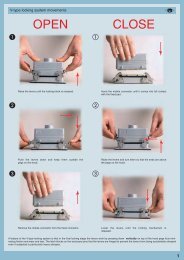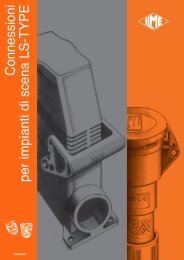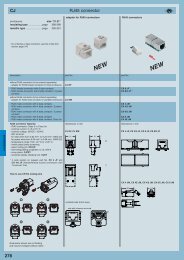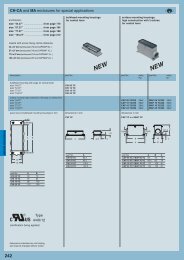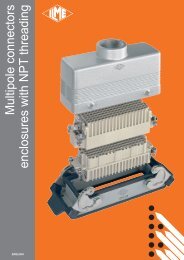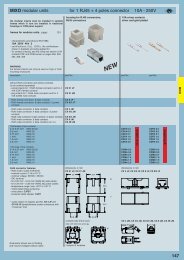download - Ilme SpA
download - Ilme SpA
download - Ilme SpA
Create successful ePaper yourself
Turn your PDF publications into a flip-book with our unique Google optimized e-Paper software.
standards for low voltage plugs, socket-outlets and distribution boardsNormal service conditions for electrical equipmentThe standard EN 60439-1 applies to low-voltage switchgear and controlgear assemblies, commonly known as low-voltage boards, with rated voltage not exceeding1000V (with frequency not exceeding 1 kHz, although boards for greater frequenciesare allowed under further specific prescriptions) or 1500V in d.c.This standard defines the equipment (boards) for indoor and outdoor use in accordancewith the installation conditions. The normal service conditions are in fact defined forindoor and outdoor use.These normal conditions are also used as reference in standard EN 60664-1 (basicsafety publication) for the coordination of insulation. This coordination consists of thedefinition of the rated insulation values of electrical equipment and the correspondingcomponents relating to:- dielectric characteristics of the insulating materials used- degree of pollution in the environment where they are to be used- overvoltage category of the point at which they are connected to the network(distance from the generating centres).1. Ambient air temperatureIn normal indoor service conditions the temperature should not be lower than -5 ˚Cor greater than +40 ˚C and the average value over 24 h should not exceed +35 ˚C.For outdoor installations the minimum value is -25 ˚C in mild climates and -50 ˚C inarctic climates (with the possibility of an agreement between manufacturer and userin the latter case).2. AltitudeThe altitude of the installation site should not exceed 2000 m. For equipment to beused at higher altitudes it is necessary to consider the reduction of dielectric rigidityand the cooling effect of the air. For installations in different conditions refer to themanufacturer.3. Atmospheric conditions:humidity and pollutionThe relative humidity of the air should not exceed 50% at a maximum temperature of40 ˚C. Higher relative humidity values are allowed at lower temperatures, for example:90% at +20 ˚C. For outdoor installations the relative humidity may reach 100% at amaximum temperature of +25 ˚C.Degrees of pollutionIP degree of protection and the EN 60529 standardThe minimum IP degree of protection is regulated by the CEI 64-8 installation standards(inclusion of the harmonisation documents of the CENELEC HD384 series and theIEC 60364 publication) which, in part 7, cover a number of special environments:construction and demolition sites, structures designed for agricultural or livestockbreeding use, restricted conductor areas, caravans and caravan sites, environmentswith a greater risk in case of fire, public performance and entertainment areas, poolsand, in the future, fountains and marinas and harbour areas. The standard is applicableto enclosures for electric materials with a rated power no greater than 72.5 kW. Allthe equipment must be installed according to gstate of the arth rules and must complywith any manufacturer’s assembly instructions. When components of differentdegrees of protection are assembled, the resulting board or distribution system willassume the lowest degree of protection of the mounted components.This has been assessed and applies:- socket-outlets, when a plug of the same degree of protection is inserted or whenthe cover is closed (with counternuts tightened for IP67).- plugs (with counternuts tightened for IP67).- for cases, when all the covers are adequately closed.The range of ILME products presented in this catalogue offers the following range ofprotection:IP44: protection against the penetration of solid foreign objects with a diameterequal to or greater than 1 mm for protection against the intrusion of dangerousparts with an access calibre of Ø 1 mm (1 st digit), and protected against thedangerous effects of water spray from all directions(2 nd digit).IP55: Protection against the penetration of harmful quantities of powder andagainst access to dangerous parts with an access calibre of Ø 1 mm (1 st digit) andprotected against the dangerous effects of water jets with a nozzle from alldirections (2 nd digit).IP66: total protection against dust and access to dangerous parts with an accessibilitycalibre of Ø 1 mm (1 st digit), and protected against powerful water jets suchas sea waves (2 nd digit).IP67: Total protection against powder and against access to dangerous parts with anaccess calibre of Ø 1 mm (1 st digit) and protected against the effects of temporaryimmersion (30’) in water at a maximum depth of 1 meter (2 nd digit).The socket-outlets with IP55 degree of protection and those with double degree ofprotection IP66/IP67 14) have a bayonet jointed lid, traditionally defined as “water-tight”and require plugs with IP67 degree of protection (with counternut and gasket) to preservethe degree of protection marked on the apparatus.The pollution degrees define the environmental conditions. To go in more detail, standardIEC 60664-1 clarifies that pollution is defined as any contribution of foreign matter,whether a solid, liquid or gaseous (ionised gas), that may negatively affect the dielectricstrength of the surface resistivity of the insulating material. Four degrees of pollution aredefined and are described by conventional numbers based on the quantity of pollutingagent or on the frequency with which the phenomenon occurs that reduces thedielectric strength and/or the surface resistivity.pollution degree 1: no pollution or only dry non-conductive pollution. The pollutionhas no influence.pollution degree 2: only non-conductive pollution except that occasionally a temporaryconductivity caused by condensation is to be expected.pollution degree 3: conductive pollution occurs or dry non conductive pollutionoccurs which becomes conductive due to condensation which is to be expected 13) .The pollution degree 3 refers to an industrial or similar environment.The pollution degree 2 refers to a household or similar environment.The third edition and the forthcoming fourth edition of EN 60309-1 standard (IEC60309-1) specifies that the normal use environment for the industrial plugs andsocket-outlets complying with this standard has a pollution degree 3 according tostandard IEC 60664-1.13)Pollution degree 4 was eliminated in the new standard edition as clearly illogical:conditions of persistent conductivity caused for example by conductive dust, rainor snow are definitely to be avoided throughout the project, and no isolating distanceis capable of withstanding them.14)The IP66/IP67 degree of protection will officially be introduced in the next amendment1 of the standards EN 60309-1 and EN 60309-2 (and of the relating IEC standards).It is already accounted for in the IP degree of protection standard EN 60529 as a”versatile” form of protection, covering the fact that the temporary immersion resistancetest (protection IPX7) does not automatically comply with the two lower degrees ofprotection IPX6 and IPX5, tested with the respective jet tests. If the end userrequires the equipment to resist both against temporary immersions and pressurizedwater jets, declaredly IP66/IP67 devices with double marking must be selected.1 st characteristic numeralPersonal protection against contact withhazardous partsIP External solid Protectionforeign bodiesnone0123456against solid foreignobjects with Ø greateror equal to 50 mm(e.g. hand)against solid foreignobjects with Ø greateror equal to 12 mm(e.g. finger)against solid foreignobjects with Ø greateror equal to 2.5 mm(e.g. tools and wires)against solid foreignobjects with Ø greateror equal to 1 mm (e.g.fine tools and wires)dust-protecteddust-tight2 nd characteristic numeralProtection of materials against harmfulpenetration of waterIP Tests Protection012345678noneagainstvertical dropsof wateragainstdrops of waterat an angle of 15°againstdrops of waterat an angle of 60°against water sprayedfrom all directionsagainst jets of waterfrom all directionsagainst powerful jets ofwater (such as seawaves)against the effect oftemporary immersion inwater at a depth of 1metreagainst the effects ofcontinuous immersion inwater60


